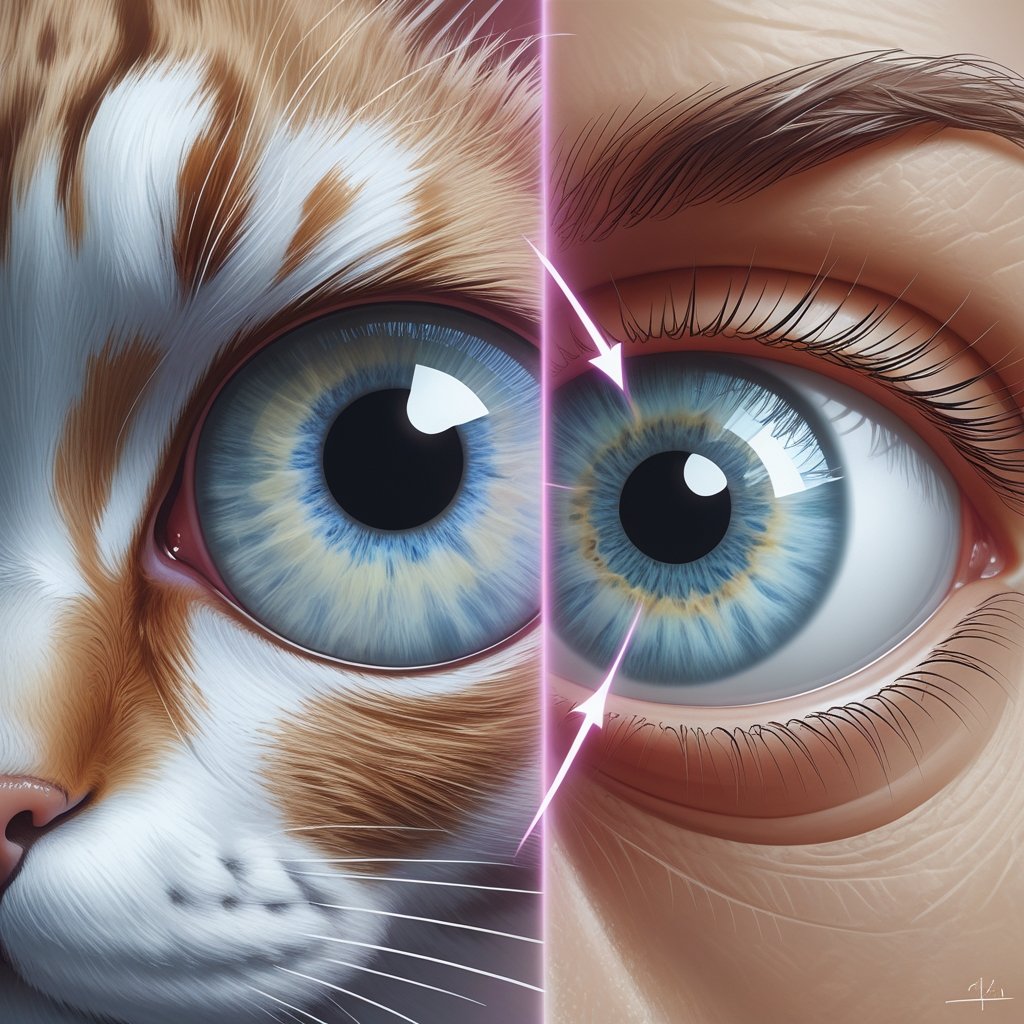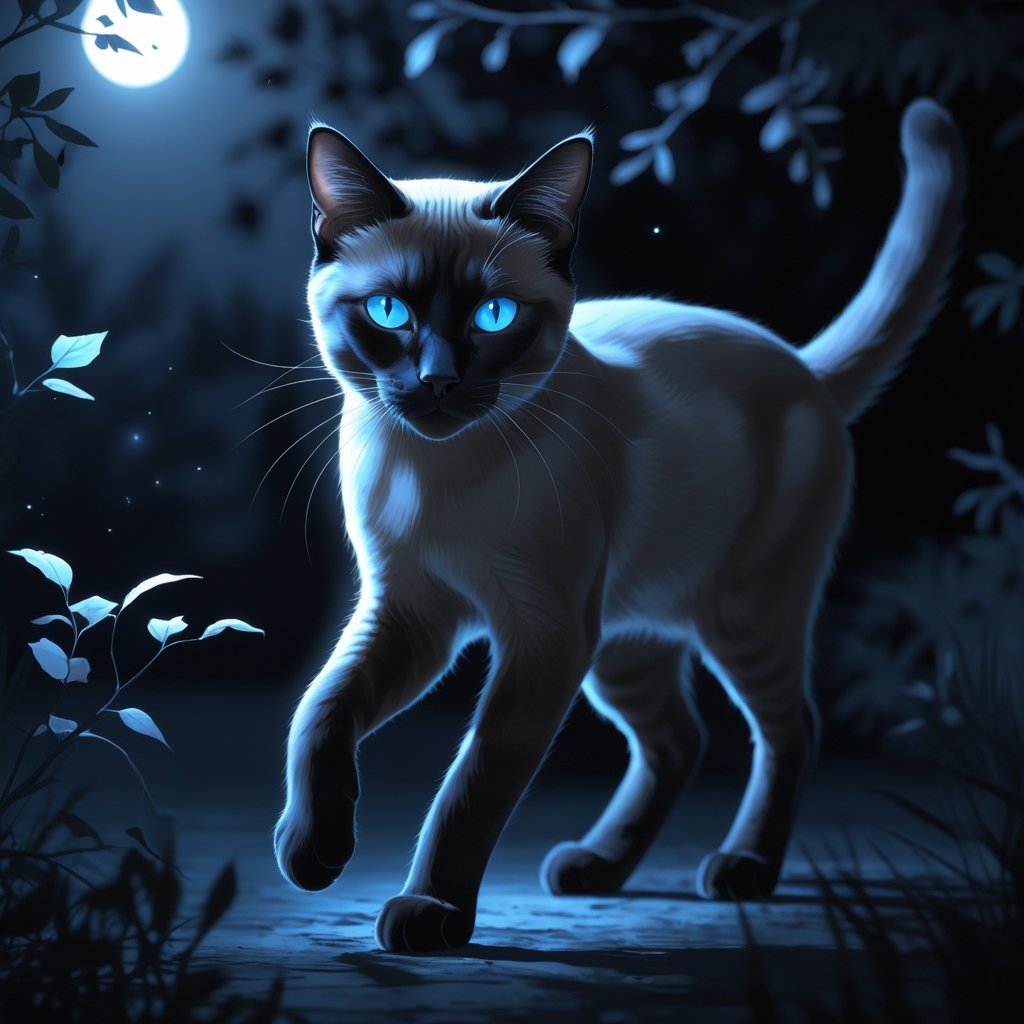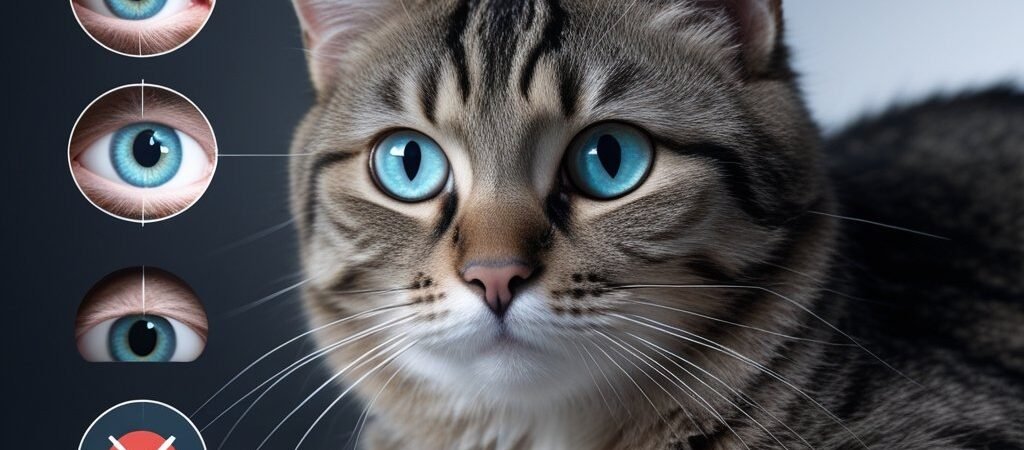Meta Description: Discover the truth about cat night vision! Learn how cats really see in the dark, debunk common vision myths, and understand your feline’s incredible visual abilities.
Have you ever watched your cat confidently leap onto furniture in a pitch-black room and wondered if they possess some kind of supernatural night vision? Or perhaps you’ve heard people claim that cats can see in complete darkness and questioned whether this amazing ability is real or just another pet myth?
The truth about cat vision is both more fascinating and more nuanced than most people realize. While cats don’t possess magical powers that let them see in absolute darkness, they do have remarkable visual adaptations that give them extraordinary low-light vision capabilities that far surpass our own human abilities.
Understanding how your cat’s vision really works will help you better appreciate their incredible sensory abilities, create a more cat-friendly environment in your home, and separate fact from fiction when it comes to feline eyesight. Let’s explore the amazing world of cat vision and bust some persistent myths along the way.
The Science Behind Cat Night Vision: How Feline Eyes Work
To understand whether cats can truly see in the dark, we need to examine the remarkable anatomy of feline eyes and how they’ve evolved to maximize light-gathering ability.
The Tapetum Lucidum: Nature’s Built-in Reflector
The secret to cats’ superior night vision lies in a special layer of tissue behind their retinas called the tapetum lucidum. This reflective layer acts like a mirror, bouncing light that passes through the retina back through it a second time. This gives the photoreceptors in your cat’s eyes a second chance to capture available light, essentially amplifying their light sensitivity.
This is also what causes your cat’s eyes to glow in photographs or when light shines on them in the dark – you’re seeing light reflecting off the tapetum lucidum. Different cats may have different colored eye shine, ranging from green and yellow to blue and orange, depending on the minerals present in their tapetum lucidum.
Rod-Heavy Retinas: Optimized for Low Light
Cat retinas contain a much higher concentration of rod cells compared to cone cells. Rod cells are photoreceptors specialized for detecting light and motion in low-light conditions, while cone cells are responsible for color vision and detail in bright light.
Cats have approximately six to eight times more rod cells than humans, giving them significantly better night vision but at the cost of some color discrimination and fine detail perception during daylight hours.
Larger Pupils and Corneas: Maximum Light Collection
Cat eyes are proportionally larger than human eyes relative to their head size, and their pupils can dilate much wider than ours. When fully dilated, a cat’s pupil can open to nearly the full width of their eye, allowing maximum light to enter. Their corneas are also larger, providing a bigger “window” for light collection.

This combination of anatomical features allows cats to use available light much more efficiently than humans, but it doesn’t mean they can see in absolute darkness.
Myth-Busting: What Cats Can and Cannot See
Let’s address some common misconceptions about cat vision and separate fact from fiction.
Myth #1: Cats Can See in Complete Darkness
The Truth: Cats cannot see in absolute darkness any better than humans can. They need at least some light to see, even if it’s just a tiny amount that would be imperceptible to human eyes. What cats excel at is making use of extremely small amounts of available light that humans cannot detect.
Even in what appears to be complete darkness to us, there’s often some ambient light from sources like digital clocks, streetlights filtering through windows, or moonlight. Cats can utilize these minimal light sources effectively thanks to their specialized eye anatomy.
Myth #2: Cats See Only in Black and White
The Truth: Cats can see colors, but not as many as humans can. While humans have three types of color receptors (for red, green, and blue light), cats primarily have receptors for blue and green light. This means cats see the world in a palette similar to what a color-blind human might see, with blues and greens appearing more vivid while reds may appear more grayish or muted.
Myth #3: Cats Have Better Daytime Vision Than Humans
The Truth: Actually, the opposite is true. Cats’ eyes are optimized for low-light conditions, which means their daytime vision isn’t as sharp as ours. Cats are somewhat nearsighted and don’t see fine details as clearly as humans do, especially at a distance. They’re better at detecting motion than focusing on stationary objects.
Myth #4: All Cats Have the Same Night Vision Abilities
The Truth: While all cats have superior night vision compared to humans, there can be variations between individual cats and even between different breeds. Factors like eye color, overall health, age, and genetics can all influence the effectiveness of a cat’s night vision.
How Good Is Cat Night Vision Compared to Humans?
To put cat night vision in perspective, cats need only one-sixth the amount of light that humans need to see clearly. This means that in lighting conditions where humans would be functionally blind, cats can navigate with relative ease.
Light Sensitivity Comparison
In optimal conditions, cats can see clearly in light levels as low as 0.125 lux (a unit of light measurement), while humans typically need around 0.75 lux to see adequately. To put this in context:
- Full moonlight: About 0.25 lux (cats see well, humans struggle)
- Starlight: About 0.002 lux (both cats and humans have difficulty)
- Indoor “darkness”: Often 0.1-0.5 lux from ambient sources (cats navigate easily, humans struggle)
Motion Detection Superiority
Cats are exceptionally good at detecting motion in low-light conditions. Their eyes can pick up movements that human eyes would completely miss in similar lighting. This ability was crucial for their ancestors’ survival as nocturnal hunters and remains one of their most impressive visual capabilities.

The Evolution of Cat Vision: Why Cats Developed Superior Night Vision
Understanding why cats evolved such remarkable low-light vision helps explain their capabilities and limitations.
Crepuscular Hunting Heritage
Cats are naturally crepuscular, meaning they’re most active during dawn and dusk when light levels are low but not absent. Wild cats evolved to hunt during these twilight hours when their prey (small mammals and birds) were active but visibility was poor for potential predators and prey alike.
This evolutionary pressure favored cats with better low-light vision, leading to the development of the anatomical features we see today. The trade-off was reduced color discrimination and fine detail vision, which weren’t as crucial for survival in their natural habitat.
Predator Advantages
Superior night vision gave cats several hunting advantages:
- Stealth hunting: Better vision in low light allowed cats to hunt when their prey had reduced visibility
- Motion detection: Enhanced ability to spot moving prey in dim conditions
- Spatial navigation: Better depth perception in low light for accurate pouncing and climbing
How Cat Vision Changes with Age
Just like humans, cats can experience vision changes as they age, which can affect their night vision abilities.
Kitten Vision Development
Kittens are born with their eyes closed and don’t open them until they’re about 7-10 days old. Even then, their vision continues developing for several weeks. Young kittens have limited vision and rely heavily on their other senses, but their night vision capabilities develop rapidly as they mature.
Adult Cat Vision Peak
Cats typically reach their peak vision capabilities by about one year of age. During their adult years, healthy cats maintain excellent night vision that far surpasses human capabilities.
Senior Cat Vision Changes
As cats age, they may experience vision changes similar to those in aging humans:
- Lens clouding: Similar to cataracts in humans, though less common in cats
- Retinal changes: Age-related changes that can affect night vision
- Reduced pupil dilation: Older cats may not dilate their pupils as effectively
- Overall sensitivity decrease: General reduction in light sensitivity
Regular veterinary eye exams become increasingly important for senior cats to monitor for age-related vision changes.
Other Remarkable Aspects of Cat Vision
Beyond their famous night vision, cats have several other fascinating visual capabilities worth understanding.
Peripheral Vision Superiority
Cats have a wider field of vision than humans – about 200 degrees compared to our 180 degrees. This gives them better peripheral vision, allowing them to detect movement from the sides without turning their heads.
Vertical Pupil Advantages
The distinctive vertical slit shape of cat pupils isn’t just aesthetically interesting – it serves important functional purposes. Vertical pupils can:
- Close more completely: Providing better protection from bright light
- Open wider: Allowing maximum light gathering in dim conditions
- Create depth of field effects: Helping with distance judgment when pouncing
Near Vision Limitations
While cats excel at distance vision in low light, they actually have difficulty focusing on objects very close to their faces (closer than about 12 inches). This is why cats often seem to “miss” treats placed right in front of their noses – they literally can’t see them clearly at that distance.
How to Support Your Cat’s Vision Health
Understanding your cat’s vision capabilities can help you create a more vision-friendly environment and maintain their eye health.
Environmental Considerations
Lighting for Aging Cats: While cats see well in low light, senior cats with declining vision may benefit from some additional ambient lighting in key areas like food bowls, litter boxes, and favorite sleeping spots.
Consistent Layout: Cats rely partly on memory and spatial awareness to navigate. Keeping furniture and important items in consistent locations helps cats navigate confidently, especially as they age.
Safe Outdoor Time: If your cat enjoys supervised outdoor time, dawn and dusk are when their vision gives them the greatest advantage for exploring safely.
Signs of Vision Problems

Watch for these potential indicators of vision issues in your cat:
- Bumping into furniture or walls, especially in familiar environments
- Reluctance to jump or climb
- Changes in activity level, particularly at night
- Difficulty finding food or water bowls
- Changes in pupil size or responsiveness to light
- Cloudiness in the eyes
- Excessive eye discharge or irritation
Regular Eye Care
Routine Cleaning: Gently clean around your cat’s eyes with a damp cloth to remove any discharge that could impair vision.
Veterinary Checkups: Regular eye examinations during routine vet visits can catch vision problems early.
Nutrition Support: A diet rich in antioxidants and omega-3 fatty acids can support overall eye health.
Comparing Cat Vision to Other Animals
Cats aren’t the only animals with impressive night vision. Understanding how they compare to other creatures puts their abilities in perspective.
Nocturnal Champions
Owls: Have even better night vision than cats, with enormous eyes relative to their body size and specialized adaptations for silent hunting.
Raccoons: Also have excellent night vision, though not quite as advanced as cats.
Dogs: Have better night vision than humans but not as good as cats, with fewer rod cells and less developed tapetum lucidum.
Diurnal Animals
Humans: Optimized for daytime color vision and fine detail, with relatively poor night vision.
Birds of Prey: Excellent daytime vision with incredible detail perception, but most have limited night vision abilities.
Frequently Asked Questions About Cat Night Vision
Q: Can cats see infrared or heat signatures like some animals?
A: No, cats cannot see infrared light or heat signatures. Their night vision relies on amplifying available visible light, not detecting different parts of the electromagnetic spectrum.
Q: Do different colored cat eyes affect night vision ability?
A: Eye color itself doesn’t directly affect night vision, but it can be related to the composition of the tapetum lucidum, which might create minor variations in light-reflecting efficiency.
Q: Why do my cat’s eyes glow different colors in photos?
A: The color of eye shine depends on the angle of the light, the minerals in your cat’s tapetum lucidum, and their age. Common colors include green, yellow, blue, and orange.
Q: Can indoor cats lose their night vision abilities?
A: Indoor cats maintain their night vision capabilities regardless of their environment. These are anatomical features that don’t deteriorate from lack of use, though they may change with age.
Q: Do blind cats navigate better than sighted cats in complete darkness?
A: Blind cats often develop enhanced spatial memory and reliance on other senses, but in truly complete darkness, both sighted and blind cats would rely on their other senses equally.
Q: Can anything improve my cat’s night vision?
A: A cat’s night vision is primarily determined by their anatomy and genetics. However, maintaining good overall health, proper nutrition, and regular veterinary care can help preserve their natural vision abilities.
The Practical Implications of Understanding Cat Vision
Knowing how your cat sees the world has practical applications for cat owners.
Home Safety
Understanding that cats can navigate well in low light but aren’t invincible in complete darkness can help you make safety decisions about leaving lights on or creating safe pathways for nighttime navigation.
Play and Enrichment
Cats’ superior motion detection makes moving toys particularly engaging, especially in lower light conditions. Their vision capabilities explain why they’re so fascinated by laser pointers and feather wands that create quick movements.
Behavioral Understanding
Many cat behaviors make more sense when you understand their visual capabilities. Their tendency to be most active during dawn and dusk aligns perfectly with when their vision gives them the greatest advantage.
Conclusion: Appreciating Your Cat’s Remarkable Vision
While cats can’t truly see in complete darkness, their night vision capabilities are genuinely remarkable and far superior to our own. The combination of specialized eye anatomy, evolutionary adaptations, and finely-tuned sensory systems gives cats an incredible advantage in low-light conditions.
Understanding the truth about cat vision helps us appreciate these amazing animals even more while also recognizing their limitations. Cats aren’t supernatural beings with magical powers, but they are beautifully adapted predators whose vision system represents millions of years of evolutionary refinement.
The next time you watch your cat confidently navigate your home in what seems like complete darkness to you, you’ll know you’re witnessing the incredible efficiency of one of nature’s most sophisticated low-light vision systems at work. These remarkable visual abilities are just one more reason why cats continue to fascinate and amaze us with their incredible sensory capabilities.
By supporting your cat’s eye health and understanding their visual world, you can help ensure they continue to experience the world through their amazing feline vision for years to come.
Have you noticed interesting vision behaviors in your cat during low-light conditions? Share your observations in the comments below!
Want to support your cat’s visual health and nighttime activities? Check out our recommendations for vision-supporting supplements, interactive toys designed for low-light play, and comfortable nighttime accessories that work with your cat’s natural vision capabilities.
Related Articles You Might Enjoy:
- “Why Cats Love Boxes (and How to Use This to Enrich Their Lives)”
- “Do Cats Dream? The Sleep Habits of Felines”
- “15 Funniest Cat Behaviors Explained”
- “Understanding Cat Body Language: What Your Cat Is Really Telling You”
Keywords: cat night vision, can cats see in the dark, feline vision, cat eyes, tapetum lucidum, cat vision myths, pet eye health, nocturnal cats, cat eyesight, feline anatomy, cat senses

